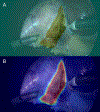Artificial Intelligence for Intraoperative Guidance: Using Semantic Segmentation to Identify Surgical Anatomy During Laparoscopic Cholecystectomy
- PMID: 33196488
- PMCID: PMC8186165
- DOI: 10.1097/SLA.0000000000004594
Artificial Intelligence for Intraoperative Guidance: Using Semantic Segmentation to Identify Surgical Anatomy During Laparoscopic Cholecystectomy
Abstract
Objective: The aim of this study was to develop and evaluate the performance of artificial intelligence (AI) models that can identify safe and dangerous zones of dissection, and anatomical landmarks during laparoscopic cholecystectomy (LC).
Summary background data: Many adverse events during surgery occur due to errors in visual perception and judgment leading to misinterpretation of anatomy. Deep learning, a subfield of AI, can potentially be used to provide real-time guidance intraoperatively.
Methods: Deep learning models were developed and trained to identify safe (Go) and dangerous (No-Go) zones of dissection, liver, gallbladder, and hepatocystic triangle during LC. Annotations were performed by 4 high-volume surgeons. AI predictions were evaluated using 10-fold cross-validation against annotations by expert surgeons. Primary outcomes were intersection- over-union (IOU) and F1 score (validated spatial correlation indices), and secondary outcomes were pixel-wise accuracy, sensitivity, specificity, ± standard deviation.
Results: AI models were trained on 2627 random frames from 290 LC videos, procured from 37 countries, 136 institutions, and 153 surgeons. Mean IOU, F1 score, accuracy, sensitivity, and specificity for the AI to identify Go zones were 0.53 (±0.24), 0.70 (±0.28), 0.94 (±0.05), 0.69 (±0.20). and 0.94 (±0.03), respectively. For No-Go zones, these metrics were 0.71 (±0.29), 0.83 (±0.31), 0.95 (±0.06), 0.80 (±0.21), and 0.98 (±0.05), respectively. Mean IOU for identification of the liver, gallbladder, and hepatocystic triangle were: 0.86 (±0.12), 0.72 (±0.19), and 0.65 (±0.22), respectively.
Conclusions: AI can be used to identify anatomy within the surgical field. This technology may eventually be used to provide real-time guidance and minimize the risk of adverse events.
Copyright © 2020 Wolters Kluwer Health, Inc. All rights reserved.
Conflict of interest statement
Conflicts of Interest and Source of Funding: There were no sources of funding for this manuscript. D.A. is a consultant for Johnson & Johnson Institute, Verily Life Sciences, Worrell, and Mosaic Research Management. D.A. and A.N.W. have received grant funding from Olympus. A.O. has received honoraria for speaking and teaching from Medtronic, Ethicon, and Merck. A.A. is a consultant for Johnson & Johnson Institute. The authors report no conflicts of interest.
Figures




References
-
- Gawande AA, Thomas EJ, Zinner MJ, Brennan TA. The incidence and nature of surgical adverse events in Colorado and Utah in 1992. Surgery. 1999;126(1):66–75. - PubMed
-
- Rogers SO Jr, Gawande AA, Kwaan M, et al. Analysis of surgical errors in closed malpractice claims at 4 liability insurers. Surgery. 2006;140(1):25–33. - PubMed
-
- Guru V, Tu JV, Etchells E, et al. Relationship between preventability of death after coronary artery bypass graft surgery and all-cause risk-adjusted mortality rates. Circulation. 2008;117(23):2969–2976. - PubMed
Publication types
MeSH terms
Grants and funding
LinkOut - more resources
Full Text Sources

